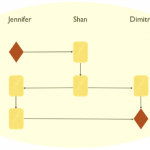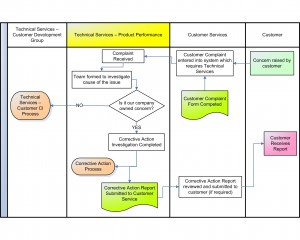A recent afternoon was spent looking at the meticulous flowcharts of processes drawn up by an innovative software company for a client. It was something the client had never done for themselves. They were astonished when they saw the result. What did they reveal?
Many people, especially in more traditional sectors, are accustomed to just getting on with the job. If there hasn’t been any reason to do so, no one will have asked them to step back and describe in detail exactly what has to happen and who does what in order to produce a result that can be sold to a customer. Day in, day out, people just come to work and do what needs to be done. But they are missing out on something of enormous value.
Map your processes
Every organization and business has goals they must achieve. So they have to be sure that all the elements inside the organization behave consistently with respect to the goals established. In order to do this they have to have a thorough understanding of how these elements interact. They must be able to see the organization as a network of interdependent processes. (See Step 2 of the 10 steps of The Decalogue methodology.)
No matter what they produce, they receive inputs that they have to transform into outputs. The best way to understand how that’s happening is to map out the processes. Why? Because mapping their processes provides a helicopter view of interactions and interdependencies. It reveals inefficiencies, redundancies and opportunities to greatly improve and accelerate flow.
Design your processes
The best people to map the processes are the ones who are most familiar them. They can quickly learn to draw the best tool for this – Deployment Flowcharts – or be helped by those who know how to. But mapping out the processes is not enough because all it does is capture how things are being done right now. Just because they’ve always been done that way doesn’t mean there isn’t a better way. Having a map of the processes is the best possible way to be able to really think about making improvements.
When you start thinking in terms of processes and improvement, it gives you the possibility to actually design the process the way it should be. In other words, you can design the reality of an organization instead of just accepting the way it is.
When there is too much hierarchical control in an organization this will create unnecessary barriers and loops (people asking for permission) for an effective flow of work. When interdependencies are mapped and designed well, the result is a smoother and faster delivery of results but also greater involvement and satisfaction.
Oh, and by the way, what if someone wants to sell you ERP software or software for digitalization and they don’t care about how your internal processes behave? Be afraid. Be very afraid!
Sign up to our blog here and shift your thinking towards broader, systemic possibilities for yourself and your organization.
About the Author
Angela Montgomery Ph.D. is the author of the business novel+ website The Human Constraint. This downloadable novel uses narrative to look at how the Deming approach and the Theory of Constraints can create the organization of the future, based on collaboration, network and social innovation. Angela is partner and co-founder of Intelligent Management and co-author with Dr. Domenico Lepore, founder, and Dr. Giovanni Siepe of ‘Quality, Involvement, Flow: The Systemic Organization’ from CRC Press, New York.







Leave a Reply